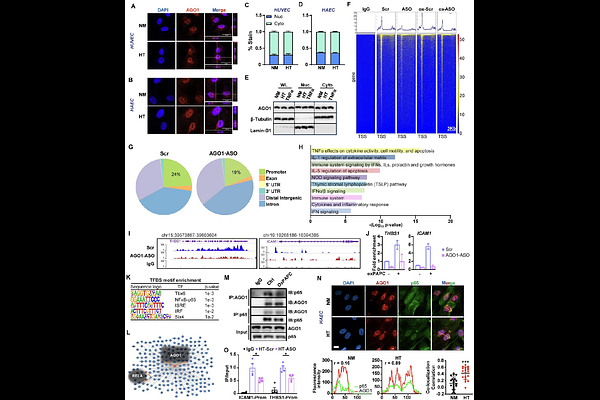Endothelial AGO1 Drives Vascular Inflammation and Atherosclerosis via a Non-Canonical Nuclear Mechanism

Endothelial AGO1 Drives Vascular Inflammation and Atherosclerosis via a Non-Canonical Nuclear Mechanism
Liu, X.; Yuan, D.; Luo, Y.; Tang, X.; Tapia, A.; Malhi, N. K.; Chadha, R. S.; Tiwari, S.; Swiderski, P.; Wang, K.-C.; Kortylewski, M.; Pardi, N.; Wei, L.; Huang, W.; Chen, Z. B.
AbstractBACKGROUND: Endothelial cell (EC) dysfunction is both a cause and consequence of vascular inflammation and lipid dysregulation in atherosclerosis, yet the molecular drivers linking EC dysfunction to systemic metabolic derangements remain incompletely understood. We previously identified Argonaute 1 (AGO1)--a canonical component of the RNA-induced silencing complex--as a regulator of EC function in angiogenesis and metabolism. In this study, we uncover a previously unrecognized, non-canonical role of nuclear AGO1 in ECs as a transcriptional coactivator of NF-{kappa}B, and demonstrate that EC-specific AGO1 inhibition simultaneously improves lipid metabolism, liver function, and vascular inflammation, thereby attenuating atherosclerosis. METHODS: EC-conditional AGO1 knockout (EC-AGO1-KO) and wildtype mice were subjected to pro-atherosclerotic models induced by AAV9-PCSK9 and a western diet, or carotid artery ligation. Metabolic and vascular phenotyping and gene expression analyses were performed. In human liver sinusoidal ECs (HLSECs) and human aortic ECs (HAECs), AGO1 was knocked down using antisense oligos (ASO), followed by assays for inflammatory responses (qPCR, RNA-seq, ELISA, and monocyte adhesion). Mechanistic studies included Cut&Tag sequencing, and chromatin immunoprecipitation assays, and EC-hepatocyte co-cultures. Therapeutic effect of AGO1 inhibition was assessed using lipid nanoparticle (LNP)-delivered ASO in mice. RESULTS: EC-AGO1-KO mice exhibited significantly improved plasma lipid profiles, reduced hepatic steatosis, inflammation, and fibrosis, and decreased aortic atherosclerotic burden. AGO1 knockdown in ECs dampened inflammatory responses and monocyte recruitment and enhanced hepatocyte lipid metabolism via paracrine signaling. Mechanistically, nuclear AGO1 interacted with NF-{kappa}B p65 to enhance transcription of pro-inflammatory genes including ICAM1, THBS1. LNP-delivered AGO1-ASO improved hyperlipidemia, liver function, and atherosclerosis without evident hepatotoxicity. CONCLUSIONS: Endothelial AGO1 promotes vascular inflammation and liver dysfunction through a non-canonical role as an NF-{kappa}B coactivator. Its inhibition provides dual benefits--ameliorating lipid dysregulation and suppressing vascular inflammation--highlighting EC-AGO1 as a promising therapeutic target for atherosclerosis and cardiometabolic diseases.